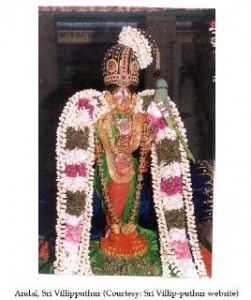(திருப்பாவை – வேதம் அனைத்துக்கும் வித்து)
In the last posting, we saw how AndAl extols the glories of nAma sankirtanam. Let us see the other features of ThiruppAvai that make it extraordinary.
anyApadesam: This is what appears on the surface, the actual literal meaning.
swApadesam: This is the essence of ThiruppAvai that is not evident to the untrained eye. All the deep and hidden meanings that lie underneath the literal meaning at several layers are called swApadesam. The profound inner meanings are numerous and fortunately our achAryAs have given brilliant swApadesams for each word and groups of words of ThiruppAvai in their commentaries. These are therefore Visesha VedARthams and hence ThiruppAvai is glorified as Vedam anaithukkum Vithu (ThiruppAvai is the seed for all VedAs)
Let us now see how SarnAgathi is conveyed as swApadesam hidden under the literal meaning of some of the pAsurams in ThiruppAvai.
The concept of Surrender (prapatti) is prescribed in Upanishads and PAncharAtra SamhithAs and reaffirmed using simple terms in ThiruppAvai. We will see briefly in this post the concept of prapatti as elucidated by Professor AS Raghavan, in AndAl the bridal mystic.
Prapatti denotes self surrender and is known by different names viz SaranAgathi (seeking refuge at the Lord’s sacred feet), BharanyAsam (Transfer of the burden and responsibility of protection of the jeevan to the Lord) and Atma Nikshepam (Surrender of the self). This SaranAgathi comprises of:
 1) doing whatever that pleases the Lord (aanukoolya sankalpam)
1) doing whatever that pleases the Lord (aanukoolya sankalpam)
2) avoiding whatever that displeases the Lord (PrAthikoolya Varjanam)
3) total faith in Him as the only one who would protect (MahA ViswAsam)
4) begging for His protection ((Gopthruva VaraNam )
5) Aathma Nikshepam ( The surrender of the Self )
6) Feeling helplessness (kaarpaNyam )
To develop unalloyed faith, one needs to develop the correct knowledge of the nature of the ParamAtma, JeevAtma, UpAya (means) , Virodhi and Phalam (fruits). These five are called Artha Panchakam. We will look into these after the introduction to ThiruppAvai is completed.
Let us now see how the concept of SarnAgathi is endorsed and commended in ThiruppAvai.
Verses 1 – 5
• AndAl without mincing words and in unequivocal terms declares in the first pAsuram itself that நாராயணனே நமக்கு பறை தருவான். She states unambiguously and with profound certainity that NarAyanan is the paramAtmA and His dayA will provide us பறை, the eternal kainkaryam to Him and Him only. She drives home the point that only His dayA is THE upAyam (உபாயம்)
• AnukUlya varjanam and the prathikUlya varjanam ( ie the activities to be done and the activities that need to be discarded ) are the mental attitudes that are required for one who surrenders yearning to do eternal kainkaryam.
In the second pAsuram, AndAl says, செய்யும் கிரிசைகள் கேளீரோ. T This refers to activities that are to be done through வாசிகம், காயிகம், மானஸம் (one’s speech, deeds and mind). Singing His glories, worshipping Him with flowers and thinking about Him constitute the actions that are to His liking and hence to be undertaken.
• Activities that are to be discarded again are of வாசிகம், காயிகம், மானஸம்
o Again in the second pAsuram, she says, தீக்குரளை சென்றோதோம். This refers to not speaking painful untruth and engaging in purposeless talk is வாசிகம்
o செய்யாதனை செய்யோம். This means not committing bhagavad, bhAgavad apachArams, abandoning one’s prescribed duties etc. . .
o நெய்யுண்ணோம் பாலுண்ணோம் here the pleasures of everyday is rejected here.
• Once the favorable activities are undertaken, unfavorable activities are rejected; Sriman NarAyanan rewards the surrendered soul by eradicating all the accumulated sins as well as the ones done after SaranAgathi. AndAl articulates this in the same pAsuram:
போய பிழையும் புகுதருவான் நின்றனவும்
தீயினில் தூசாகும்
The first pAsuram incidentally also suggests the meaning of AstAksharam by referring to unalloyed servitude to Sriman NarAyanA alone, seeking refuge at the feet of Sriman NarAyanA alone and reaching Him alone as the supreme goal. Again the second pAsuram suggests the meaning of Dwaya mantram by conveying the injunction that one who has surrendered must not seek other devathAs.
SaranAgathi in ThiruppAvai is an esoteric topic by itself and has to be learnt under the tutelage of a qualified AchAryA. I have tried to give very rudimentary understanding of this topic here.
Please enjoy another picture of our GodAdevi.
Will be continued………
AndAl Thiruvadigale Saranam .
by Smt Geetha Rangarajan










Please keep me posted of all the festivals and The explanations od Thirrupaavai I like your postings and would like to know more about Vaishnava Sampradhayam
Excellent work done by you for Srivaishnavas.
Pl continue and we will support you
Thanks a lot for your comments and support